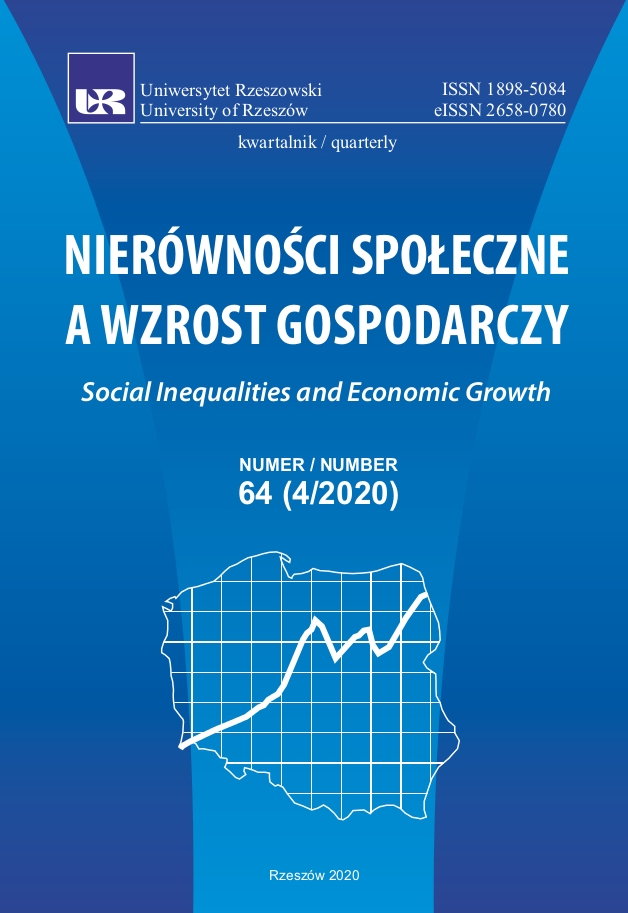Organizational commitment and level of satisfaction of employees’ psychosocial needs
DOI:
https://doi.org/10.15584/nsawg.2020.4.13Keywords:
organizational commitment, psychosocial needs satisfactionAbstract
Employee commitment to a company is an important factor affecting the stability and effective functioning of the organization. The authors of the article demonstrate the multifaceted nature of the concept of “organizational commitment” and its close relationship with the concept of “organizational involvement”. They emphasize the importance of meeting the basic psychosocial needs of employees by the organization.
The goal of the study was to assess the relationship between the degree of satisfaction of the basic psychosocial needs and organizational commitment. According to the approach of Maslow, apart from economic needs, the basic psychosocial needs include the need for safety, acceptance, respect and self-actualization. The study covered a group of 448 students at the Cracow University of Economics who had work experience. The majority of the participants of the research were young people, up to the age of 30 years (more than 90%), and women (82%). The study used Meyer and Allen’s Organizational Commitment Survey, the five-point Basic Psychosocial Need Satisfaction Scale and the five-point Organizational Involvement Self- Assessment Scale developed by the authors.
The results of the study confirm the significant relationship between the satisfaction of psychosocial needs and commitment to the organization in the studied group. It is worth emphasizing that the above-mentioned positive correlations occur between the degree of satisfaction of needs and the organizational commitment with regard to higher needs, such as respect and self-actualization. While considering the components of organizational commitment, the strongest relationship found is between the aforementioned needs and affective commitment component (r = 0.48 and r = 0.49). On the other hand, no correlation between the degree of satisfaction of basic psycho-social needs and the continuance component was found.
Downloads
References
Bańka, A., Wołowska, A., Bazińska, R. (2002). Polska wersja Meyera i Alen Skali przywiązania do organizacji. Czasopismo Psychologiczne, 8(1), 65–74.
Bańka, A., Wołowska, A. (2006). Zmiana rzeczywistości organizacyjnej a postawy wobec pracy: analiza typów przywiązania do pracy i zaangażowania w pracę. W: B. Rożnowski, A. Biela, A. Bańka (red.), Praca i organizacja w procesie zmian (s. 123–139). Poznań: Stowarzyszenie Psychologia i Architektura.
Bilgin, N., Demirer, H. (2012). The examination of the relationship among organizational support, affective commitment and job satisfaction of hotel employees. Procedia – Social and Behavioral Sciences, 51, 470–473. DOI: 10.1016/j.sbspro.2012.08.191.
Choi, D., Oh, I.-S., Colbert, A. E. (2015). Understanding Organizational Commitment: A Meta-Analytic. Examination of the Roles of the Five-Factor Model of Personality and Culture. Journal of Applied Psychology, 100(5), 1542–1567. DOI: 10.1037/ apl0000014.
Choo, J. L., Desa, N. M., Asaari, M. H. (2016). Flexible Working Arrangement toward Organizational Commitment and Work-Family Conflict. Studies in Asian Social Science, 3(1), 21–36. DOI: 10.5430/sass.v3n1p21.
Chrupała-Pniak, M., Grabowski, D. (2016). Etyka pracy, przywiązanie organizacyjne a gotowość do podejmowania nieetycznych zachowań proorganizacyjnych – raport z badań. Psychologia Społeczna, 1(36), 69–83. DOI: 10.7366/1896180020163606.
Fisher, R., Ury, W., Bruce, P. (2016). Dochodząc do tak. Warszawa: PWE.
Frank, E., Branstatter, V. (2002). Approach versus avoidance: different types of commitment in intimate relationships. Journal of Personality and Social Psychology, 82(2), 208–221. DOI: 10.1037/0022-3514.82.2.208.
Gojny, M. (2013). Znaczenie zaangażowania i intencji odejścia dla retencji pracowników w kontekście postrzeganego wsparcia organizacji. Zeszyty Naukowe Politechniki Łódzkiej, 1146, T. Organizacja i Zarządzanie, 127–138. DOI: 10.34658/ oiz.2013.51.127-138.
Griffin, R. W. (2017). Podstawy zarządzania organizacjami. Warszawa: PWN.
Juchnowicz, M. (2010). Zarządzanie kapitałem ludzkim a poziom zaangażowania pracowników. Zarządzanie Zasobami Ludzkimi, 3–4, 57–66.
Król, M. (2012). Retencja versus elastyczność zatrudnienie: determinanty strategiczno-kulturowe. Edukacja Ekonomistów i Menadżerów, 1(23), 23–41. DOI: 10.5604/01.3001.0009.5768.
Lewicka, D., Pec, M. (2017). Czynniki kształtujące przywiązanie trwania pracowników. Studia i Prace WNEIZ US, 48(2), 197–207. DOI: 10.18276/sip.2017.48/2-17.
Lewicka, D., Rożenek, P. (2016). Determinanty przywiązania afektywnego. Zeszyty Naukowe Wyższej Szkoły Humanitas. Zarządzanie, 2, 225–238. DOI: 10.5604/18998658.1199381.
Łaguna, M., Mielniczuk, E., Żaliński, A., Wałachowska, K. (2015). Przywiązanie do organizacji i zaangażowanie w pracę – koncepcje teoretyczne i problemy terminologiczne. Medycyna Pracy, 66(2), 277–284. DOI: 10.13075/mp.5893.00169.
Maslow, A. H. (1990). Motywacja i osobowość. Warszawa: Instytut Wydawniczy Pax.
Meyer, J. P., Allen, N. J. (1991). Three-component conceptualization of organizational commitment. Human Resource Management Review, 1, 65–69. DOI: 10.1016/1053- 4822(91)90011-Z.
Meyer, J. P., Allen, N. J. (1997). Commitment in the Workplace: Theory, Research and Application. Thousand Oaks, CA: Sage Publications. DOI: 10.4135/9781452231556.
Peplińska, A., Godlewska-Werner, D., Celińska, S., Nieckarz, Z., Połomski, P. (2018). Przywiązanie do organizacji i motywacja do pracy a poziom materializmu pracowników – pośrednicząca rola satysfakcji z pracy. Zarządzanie Zasobami Ludzkimi, 1, 11–30.
Pocztowski, A. (2007). Zarządzanie zasobami ludzkimi. Warszawa: PWE.
Ramay, A., Ramay, M. (2012). Antecedents of Organizational Commitment of Banking Sector Employees in Pakistan. Serbian Journal of Management, 7(1), 89–102. DOI: 10.5937/sjm1201089A.
Rego, P., Lopes, M. P., Nascimento, J. L. (2016). Authentic Leadership and Organizational Commitment: The Mediating Role of Positive Psychological Capital. Journal of Industrial Engineering and Management, 9(1), 129–151. DOI: 10.3926/jiem.1540.
Robinson, D., Perryman, S., Hayday, S. (2004). The Drivers of Employee Engagement. Brighton: Institute For Employment Studies.
Rosenberg, M. B. (2013). To co powiesz może zmienić świat. Warszawa: Wydawnictwo Czarna Owca.
Rosenberg, M. B. (2016). Porozumienie bez przemocy. Warszawa: Wydawnictwo Czarna Owca.
Talib, Z. A., Don, Y., Daud, Y., Raman, A. (2015). Organizational Culture and Organizational Commitment of Kedah District Education Officers. International Journal of Management Sciences, 5(5), 410–419.
Ury, W. (2014). Odchodząc od nie. Warszawa: PWE.
Vance, R. J. (2006). Employee Engagement and Commitment: A guide to understanding, measuring, and increasing engagement in your organization. Alexandria: The SHRM Foundation.
Wołpiuk-Ochocińska, A. (2016). Zaangażowanie w pracę i przywiązanie organizacyjne pracowników w przedsiębiorstwach o różnym poziomie kultury bezpieczeństwa pracy. Zeszyty Naukowe Wyższej Szkoły Zarządzania Ochroną Pracy w Katowicach, 1(12), 135–148.
Downloads
Published
How to Cite
Issue
Section
License
Copyright (c) 2020 University of Rzeszow

This work is licensed under a Creative Commons Attribution-ShareAlike 4.0 International License.


